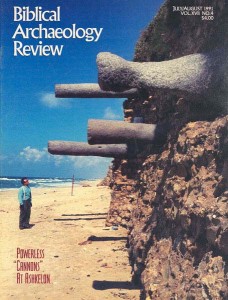Bones of a Hundred Infants Found in Ashkelon Sewer
Sidebar to: Eroticism and Infanticide at Ashkelon
Excavation of the Roman-Byzantine sewer system associated with the bathhouse at Ashkelon revealed the skeletons of nearly 100 infants. They were found mixed in with the garbage more commonly associated with such contexts—broken potsherds, animal bones, murex shells and odd coins. Most of the infant bones were intact, and all parts of the skeleton were represented. Since infant bones are fragile, they tend to fragment when disturbed or moved for secondary burial. The good condition of the infant bones at Ashkelon indicated to us that the infants had been tossed into the drain soon after death with the soft tissues intact. This manner of disposal of the infants indicates a rather callous attitude, suggesting that these might represent abortions or infanticide, rather than death from natural causes.
We focused closely on the age range of the infants as one indication of the cause of death. The rationale for using age range as an indicator of the cause of death is that perinatal death in all populations studied shows a comparable pattern of mortality. There is a high rate of mortality in the first month of life that gradually decreases over the first year, followed by a second peak at weaning. If the drain served as a mass grave following some catastrophe, or was the normal way of disposing of infants who died when young and were not accorded full burial rites, then we should expect some variability in the age of death of the infants in the drain. If on the other hand, these infant skeletons were the result of infanticide practiced immediately after birth, all would be of the same age.
Already a library member? Log in here.
Institution user? Log in with your IP address.

